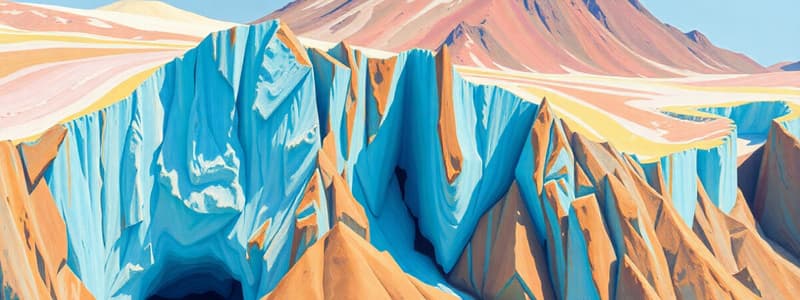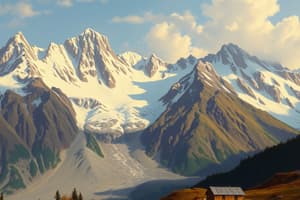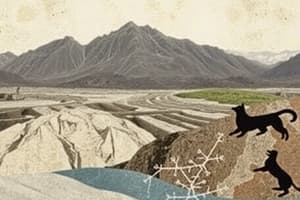Podcast
Questions and Answers
What is a glacier?
What is a glacier?
A large mass of moving ice and snow on land
What is an ice sheet?
What is an ice sheet?
A large mass of compressed ice
What is a glacial period?
What is a glacial period?
A period of cooler climate characterized by the advancement of glaciers
What is glacial advance?
What is glacial advance?
What is glacial retreat?
What is glacial retreat?
What is glacial ablation?
What is glacial ablation?
What is an interglacial period?
What is an interglacial period?
What is paleoclimate?
What is paleoclimate?
What are Milankovitch Cycles?
What are Milankovitch Cycles?
What is solar insolation?
What is solar insolation?
What are Glacial-Interglacial Cycles?
What are Glacial-Interglacial Cycles?
What is the Ice-Albedo Effect?
What is the Ice-Albedo Effect?
What is a Glacial Maximum?
What is a Glacial Maximum?
What is the Geological Time Scale?
What is the Geological Time Scale?
What is the Paleolithic Era?
What is the Paleolithic Era?
What is the Lower Paleolithic Era?
What is the Lower Paleolithic Era?
What is the Middle Paleolithic Era?
What is the Middle Paleolithic Era?
What is the Pre Pottery Phase?
What is the Pre Pottery Phase?
Flashcards
Glacier
Glacier
A large mass of moving ice and snow on land.
Ice Sheet
Ice Sheet
A large mass of compressed ice.
Glacial Period
Glacial Period
A period of cooler climate characterized by the advancement of glaciers.
Ice Age
Ice Age
Signup and view all the flashcards
Glacial Advance
Glacial Advance
Signup and view all the flashcards
Glacial Retreat
Glacial Retreat
Signup and view all the flashcards
Glacial Ablation
Glacial Ablation
Signup and view all the flashcards
Interglacial Period
Interglacial Period
Signup and view all the flashcards
Paleoclimate
Paleoclimate
Signup and view all the flashcards
Milankovitch Cycles
Milankovitch Cycles
Signup and view all the flashcards
Solar Insolation
Solar Insolation
Signup and view all the flashcards
Glacial-Interglacial Cycles
Glacial-Interglacial Cycles
Signup and view all the flashcards
Ice-Albedo Effect
Ice-Albedo Effect
Signup and view all the flashcards
Glacial Maximum
Glacial Maximum
Signup and view all the flashcards
Geological Time Scale
Geological Time Scale
Signup and view all the flashcards
Paleolithic Era
Paleolithic Era
Signup and view all the flashcards
Lower Paleolithic Era
Lower Paleolithic Era
Signup and view all the flashcards
Middle Paleolithic Era
Middle Paleolithic Era
Signup and view all the flashcards
Upper Paleolithic Era
Upper Paleolithic Era
Signup and view all the flashcards
Mesolithic Era
Mesolithic Era
Signup and view all the flashcards
Neolithic Era
Neolithic Era
Signup and view all the flashcards
Pre Pottery Phase
Pre Pottery Phase
Signup and view all the flashcards
Pottery Phase
Pottery Phase
Signup and view all the flashcards
Study Notes
Glacial Features and Processes
- Glacier: A large mass of moving ice and snow on land.
- Ice Sheet: A massive compressed ice mass.
- Glacial Period: A cold period marked by glacier advancement.
- Ice Age: A very cold period with extensive ice sheets.
- Glacial Advance: Glacier movement due to snow exceeding ablation.
- Glacial Retreat: Glacier movement back due to high ablation.
- Glacial Ablation: Ice loss from melting, evaporation, sublimation, wind, and calving.
- Interglacial Period: A warmer interval between glacial periods.
- Paleoclimate: Past climates.
- Milankovitch Cycles: Earth's orbital and tilt changes affecting glacial/interglacial cycles.
- Solar Insolation: Sun's energy reaching Earth's surface.
- Glacial-Interglacial Cycles: Earth's cooling trends driven by orbital variations, affecting ice sheet growth/melt.
- Ice-Albedo Effect: Ice reflecting sunlight, leading to melting and further warming.
- Glacial Maximum: Point where ice sheets reach maximum extent.
- Geological Time Scale: A timeline of Earth's history divided into eras.
Prehistoric Eras and Cultures
- Paleolithic Era: The Old Stone Age (2.5 million to 10,000 years ago), nomadic hunting and gathering.
- Lower Paleolithic Era: Early Paleolithic, simple tool types (choppers, bifaces).
- Middle Paleolithic Era: Cultural developments like jewelry and art, more complex tools.
- Upper Paleolithic Era: Organized settlements, improved hunting, and the earliest art forms.
- Mesolithic Era: Middle Stone Age; Smaller and more complex tools.
- Neolithic Era: New Stone Age; Fire, tools like saws and drills, and subsistence strategies change.
- Pre-Pottery Phase: Early Neolithic period, permanent settlements, new subsistence strategies.
- Pottery Phase: Later Neolithic period, pottery production, notably in specific regions.
Studying That Suits You
Use AI to generate personalized quizzes and flashcards to suit your learning preferences.




